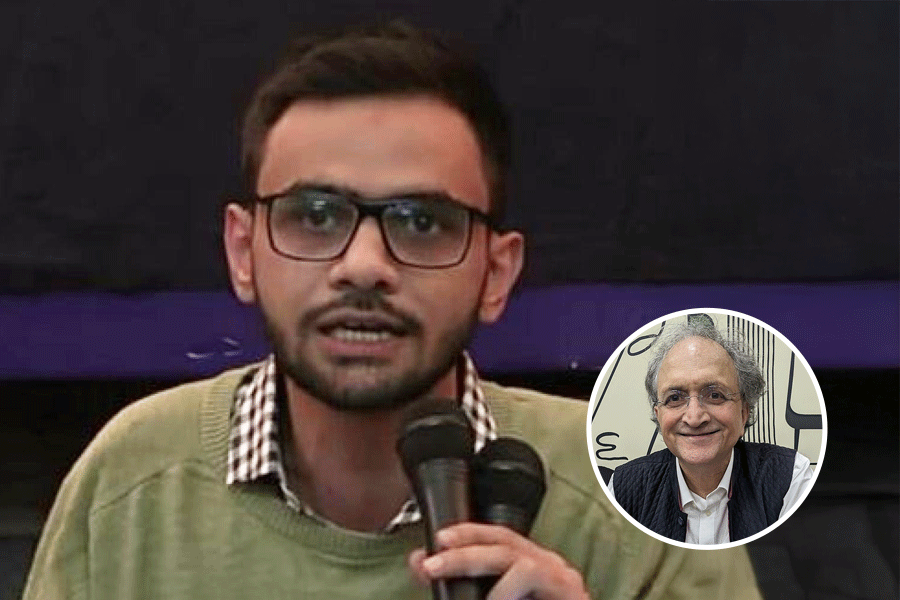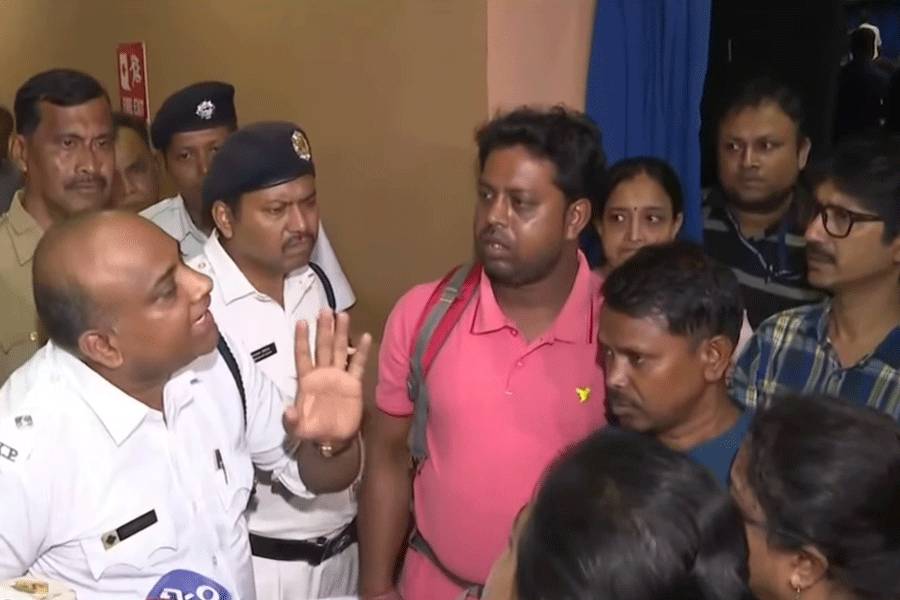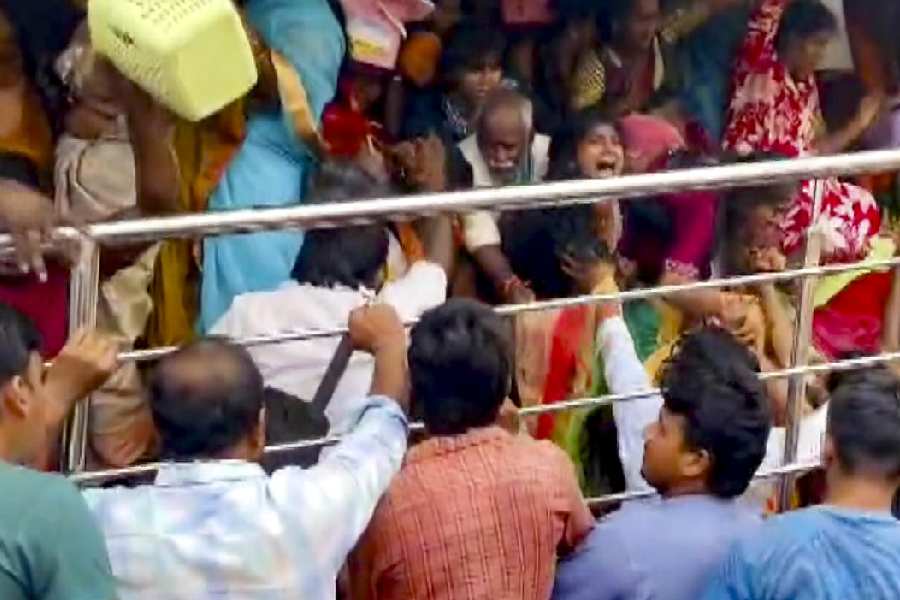-

P.C. Sorcar Junior and Maneka (right, and below) have been mesmerising audiences with their magical illusions.Pic by Rashbehari Das.
.jpg)
Pic by Sanat Kumar Sinha
In 1937 a young Indian magician sailed to Japan on a cheap cargo ship that also took a few passengers. He was only 24 and could barely afford the long ocean journey. But P.C. Sorcar held audiences mesmerised from the moment he stepped on stage in his exotic Oriental turban. Even the top Japanese illusionists were baffled at how he pulled off his most ambitious tricks like X-Ray Eyes.
Fast-forward 75 years as P.C. Sorcar Junior and his daughter Maneka step onto the stage for a joint performance at Calcutta's Mahajati Sadan. Between them the two magicians stick swords and spears into their assistants and in a special act, Junior is carved up with an electric saw. Maneka works her own special brand of magic by making a large statue of Venus vanish.
You could say that precious little has changed in all these years as the magic wand has been passed from Sorcar Senior to his son Sorcar Junior and then to Maneka. We've moved from the era of steam ships to the Age of the Internet and Junior and his daughter are making audiences gasp in amazement as they levitate assistants or even make famous monuments vanish. 'I am carrying forward a lineage while trying to carve out my own niche,' says Maneka.
This, in fact, is a centenary year for the Sorcars. Senior was born in February 1913. Over the course of the year, there will be more shows to celebrate the centenary. Last year they held an exhibition at Gorky Sadan which included artefacts like Senior's costumes and old posters of shows held in different parts of the world. Pride of place went to the electric saw he used on a BBC show and created a mild sensation by carving up an assistant.
A large garlanded portrait of Senior dressed in his trademark turban and sherwani gazes down benignly on everyone who steps into the sprawling office of Junior in Indrajaal Bhavan, one of the Sorcar houses. On one wall of the office the shelves are crammed with awards gathered over the years by the Sorcars.
-
.jpg)
Sorcar Senior preparing an assistant for his famous Cutting a Lady in Half act.
But the office is more about muggle-like chaos than magic. A wall is stacked with bookshelves that rise all the way to the ceiling — they're all magic books, but we have to take Junior's word for it as he doesn't allow nosy journalists to check out the titles.
Nevertheless, there's no mistaking that this is not an ordinary corporate office or a middle-sized import-export firm. On one shelf is a rope that's coiled like a snake in attack position — it's part, of course, of the Indian rope trick. And on one table there's a crystal ball, which seems appropriate in a magician's office. Other props are smaller versions of what they use in their stage shows — for instance, a foot-and-a-half high version of the 8-ft statue of Venus that Maneka uses for her Vanishing Venus act.
Besides that there are props of all sizes and shapes that are utterly mystifying to a non-magical person. 'They're very technical. You won't understand what they're used for,' says Maneka.
Junior is a consummate performer and a fascinating storyteller, whether it's onstage or off. He tells of how, as a youth, he was banned from his father's office but would peep in from a skylight. He makes the story come alive by asking an assistant to bring a book that has a black-and-white photograph of his father's study. He turns to the photograph and shows where the skylight was and how he would spy on his father.
-
.jpg)
A show poster on display at the exhibition that marked Senior's birth centenary
But his father always dismissed Junior until one day the young boy heard Senior's assistants threatening that they wouldn't take part in the next show. The boy grabbed the opportunity and stepped forward to assist his father. From that moment there was never any doubt about his future career.
It was very different for Maneka especially since she is a woman. 'I was born into magic,' she says with a smile. Like her father she also began by assisting her parent when she was just nine. She made a formal debut into the world of magic when she was much older in 1999.
Maneka has her own office in the same building but she meets us sitting at her father's desk. She reckons that it's crucial to be a magician's assistant. The assistants, she says, are constantly in the penumbra of vision and thus are usually the ones executing the 'trick'.
-
.jpg)
Junior performs his trademark X-ray Eyes trick.Pic by Sanat Kumar Sinha.
'You have to have an exhibitionist streak and a very thick skin. Women are assistants, never the main course. I've had to walk the extra mile to prove myself,' says the 30-something.
Both Junior and Maneka knew they needed to perform an extraordinary act of showmanship to establish themselves in the world of magic. Junior, in his 20s, decided to do this by getting himself put into a sack, then sealed in a box bound with steels chains, and thrown into the ocean. His aim was to beat Harry Houdini. Junior escaped in less than 90 seconds.
Maneka too knew it was crucial to take a leaf out of her father's dare-to-grab-attention guidebook. So, for one dramatic act, when she was just 18, she had herself strapped with dynamite sticks and got herself packed into a box covered with straw and bamboo, which was then torched. As intended the box exploded and turned into a spectacular conflagration. The fire brigade was called. But yelling to the people to make way for the fire engine was the young woman herself.
'Magic can't be taught,' says Junior, 'we can discuss things, and Maneka has every right to reject it.' Though Maneka receives training from her father, he's very particular about her finding her own answers.
-
.jpg)
Sorcar Junior offers to be sawed in half for one of his more popular acts.Pic by Sanat Kumar Sinha.
Inevitably, both Junior and Maneka spend half their lives on the road, performing across the world. Maneka reckons she's travelling for about two-and-a-half weeks a month — though she has tried to cut back in the last year ever since she got married.
Nowadays, the highlight of many a joint show is a jugalbandi between father and daughter in which each tries to outdo the other. Junior estimates he's done shows in about 36 countries and Maneka has performed solo acts in the US, Europe, New Zealand and the Middle East. Most recently she toured Spain. And while her father does over 400 shows a year (multiple ones on some days) on an average, she performs in over 300 shows a year, in India and abroad. Of these, above 100 are solo. The pair do about 100 joint shows in Calcutta.
As for the equipment and crew, it's a mini country on wheels. Each show involves anywhere between 25 tonnes and 40 tonnes of equipment and about 50 assistants and innumerable costumes.
But does magic still cast the same spell as before or is it going the way of other forms of entertainment that have been upstaged by TV and the Internet? The Sorcars say their shows have seen a dramatic increase in audience numbers.
And Indian exoticism still sells they say — especially in the US. 'People come to India for magic, mysteries and mysticism,' says Maneka. Which is why they still highlight the 'exotic East' angle in their shows like Senior had done. But they also innovate, introducing at least two new tricks a year. But the basic format of their shows remains the same.
All this is a far cry from the times of Senior who made it up from near poverty. He grew up in, what is now, Bangladesh, and once suggested to his father that they cover the soles of their feet with the dry bark of a banana tree because the intense heat of the day was making it difficult to walk. The father sold his spectacles the next day to buy his son a pair of cheap slippers.
The young boy shifted to Calcutta at a time when magicians earned hardly anything. Incidentally, there had been a tradition of magic in the family for several generations but they had kept it quiet for fear of being accused of black magic. Senior rose and in 1964 was awarded the Padma Shri.
It was in 1971 that Junior faced the most testing moment of his life and had to step into his father's shoes — almost literally. Senior had a heart attack after a show in Japan. Four days later Junior put on a 12-kg embroidered coat that his father had worn at his last show. It was still wet with perspiration. He then went on to complete his father's tour.
In 2000, Junior made the Taj Mahal vanish for two minutes, after making a moving train full of passengers vanish in front of a large crowd at Bardhaman Junction in 1992. The city's iconic Victoria Memorial also did the vanishing act on the 300th anniversary of Calcutta.
Ask Maneka her about her biggest show in the recent past and pat comes the reply. 'My wedding. And I won't be performing this one again,' she laughs. 'He says I cast a spell on him and made him forget his 'past life' in the States,' she says about her husband, an entrepreneur who lived in the US for 18 years.
How much do they practice? That differs from one show to another. Preparing for a performance can take Maneka about four to five hours, while her father may make his way to Indralok Magic Research Centre in Baruipur (where the crew practices) intending to stay for a day but end up staying for five.
He also conjures up time to study. Junior was in the middle of his MSc exams when his father passed away. He returned from Japan to complete it, and recently did his Phd at the behest of his family. Maneka has an MBA degree from Ohio State University.
Though her sisters Moubani and Mumtaz perform with their father, they chose acting instead of magic as their profession. Junior's younger brother Provas and nephew Pouroosh have also been performing magic. However, the two families have never performed together.
'Magic is a way of life for us,' smiles Junior. As father and daughter pose in front of the patriarch's portrait in their office, one realises that magic is also an heirloom in the family — passed on from one generation to the next.










